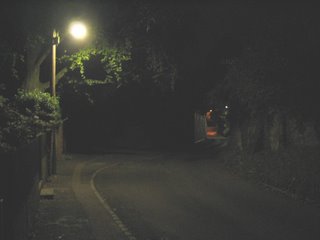Church Lane, Harwell
A practical demonstration illustrating the clear superiority, on every level except raw lumen-output, of "outmoded" mercury-vapour streetlights over their Home Office Approved high-pressure sodium replacements. Here then, from a pedestrian's perspective, is a November evening's walk around the leafy lanes of Harwell village, South Oxfordshire. [
map] The first picture shows exactly what you might expect: a narrow tree-lined village lane; a peaceful idyll.

Standing under a mercury lamp's gentle radiance as in the second picture, we see all the important information. We see the road-surface, we see the pavement and a clear delineation 'twixt the two. We see a mature brick wall covered in creepers, we see verdant trees and hedges. We see all this with our mesopic night-time vision, our eyes having adjusted to the conditions. We see a dusky-peach stain in the near-distance. We see someone's moving house.

You can hardly blame them. For when standing by the estate-agency board as in this next picture, we see a very different scene. The poor colour-rendering of this High-Pressure Sodium lamp means that instead of easy-on-the-eye natural contrasts, all an aid to night-time visibility, we are presented with a scene of sodium splurge. Detail is subsumed by reflected glare and the direct glare from the fitting itself. This SON light is many times brighter than the mercury-lamp behind us, and yet our actual ability to
see is reduced. The glare creates an area of bold shadow directly ahead of the lumiere, which means that a piece of pavement just twenty yards away is rendered blind. Our eyes start adjusting to the multifold increase in light-level. We squint against the sudden glare. We feel a headache coming on.

Standing under this light, and with the camera on exactly the same settings
* as in the first picture, I took this. The road may
appear "well-lit" from a British Standards perspective, as there's certainly a lot of dusky-peach luminosity bouncing around. So much in fact, that not only is important detail subsumed and rendered inconsequential, but the unlit section ahead of us is rendered blind. And is this
really how we want our villages to look? The searing intensity of this awful light represents an antithesis to what people like about village-life.

Turning around to look back at the mercury-vapour lamp, this picture gives an excellent demonstration of the qualitative differences between the two lighting-sources. One suggests tranquility, one suggests a military installation.
Even when standing directly underneath the sodium glare, you'll see that the pavement is markedly more apparent under the mercury light in the near-distance than it is in the foreground. The sodium light is so bright in fact, that even it's light-polluting bounce from the metalled road-surface feels uncomfortably glary. In wet conditions, this effect is, naturally enough, many times worse.
The Cleave
By the time I've arrived at Church Lane's junction with The Cleave, I'm starting to feel some aggression beating about my temples. I mean, How
dare they? Who could
possibly...? What were they
thinking...? etcetera, etcetera, etcetera. I'll leave you to enjoy the scenery for a moment while I take some aspirin.


Note the near-full moon making a valiant bid for dominance, but falling several starbursts short of the civilising influence from myopic man. Enlarge the first picture [click that thang] and you'll see another level of detail. Rooftops. Try and imagine them without the repugnant orange sodium glare; their clay tiles glinting silver in the moonlight, their chimney-pots dark shapes against a deep blue horizon. Imagine a galaxy of stars in the firmament; a natural wonder observed as routine by all preceding generations, but denied to us.
Wantage Road

The last remaining mercury-vapour lamp on the Wantage Road stands at the junction of Tyrells Close and provides the foreground illumination in this picture. An illumination which is clearly more up to the task than the stupidly bright and sickly sodium stains ahead of us.
High Pressure Sodium's increased lumen-output does not equate to "better" streetlighting.It is a wholly un-natural light; ugly in the extreme, uncomfortable, glaring and downright dangerous in that it causes blind-spots due to the eyes' need to keep re-adjusting in the glary conditions.
Drivers' reaction times have been shown to be many times slower under orange/dusky-peach sodium light than they are under "colder" white-light sources such as mercury-vapour or metal-halide.In keeping with the national trend of introducing ever-higher levels of streetlighting, as advocated by a
misguided Home Office policy, these villages' sense of rural tranquility is all but lost, and for what? Politicians' populist knee-jerk responses to the very social malaises they encourage their electorates to fear. "Oh, we're doing something about
crime, do you see?" What they actually mean is "Never mind the growing body of evidence demonstrating an inverse relationship between levels of artificial lighting and incidences of criminal behaviour, that's too complicated to explain to the poor dears, we'll just get out the Ugly Gun, give 'em what they think is good for 'em, show willing and get ourselves re-elected."
The evidence is that these overkill lighting-levels actually lead to a heightening in instances of criminality in areas where HPS has replaced older lighting-schemes. That high levels of ugly municipal lighting actually does
breed criminal behaviour. I suppose that if people are treated as errant, untrustworthy schoolchildren who need keeping tabs on, we will respond in kind.
I didn't have the airgun with me.
* Camera and settings used:Canon A75 digital camera. Exposure 0.25s @ f2.8. ISO 200, no flash. All images brightened by 20% with Canon Photo Impression 5. The LCD on this camera always gives a brighter reading of events than is seen once the pictures have been transferred to the computer. This is not a trickery motivated by my hatred of high-puke sodium; the same level of compensation has been applied to all the pictures.











